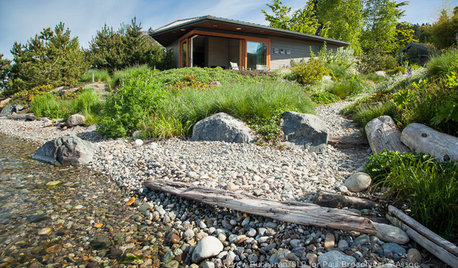Redoing a lawn - repairing old lawn
MissMoss
11 years ago
Related Stories

INSPIRING GARDENSLawn Gives Way to a More Natural Lakeside Garden
Meadow grasses, beach pebbles and driftwood replace turfgrass in a nature-friendly landscape on Lake Washington’s shore
Full Story
LANDSCAPE DESIGNGet Along With Less Lawn — Ideas to Save Water and Effort
Ditch the mower and lower your water bill while creating a feast for the eyes with diverse plantings and gathering places
Full Story
LANDSCAPE DESIGN15 Great Ideas for a Lawn-Free Yard
End the turf war for good with hardscaping, native grasses and ground covers that save water and are easier to maintain
Full Story
BEFORE AND AFTERSSee 6 Yards Transformed by Losing Their Lawns
Wondering whether a turf lawn is the best use of your outdoor space? These homeowners did, and they found creative alternatives
Full Story
FRONT YARD IDEASBefore and After: Front Lawn to Prairie Garden
How they did it: Homeowners create a plan, stick to it and keep the neighbors (and wildlife) in mind
Full Story
EARTH DAYThe Case for Losing the Traditional Lawn
Work less, help the environment and foster connections by just saying no to typical turf
Full Story
GREAT HOME PROJECTSHow to Replace Your Lawn With a Garden
New project for a new year: Lose the turfgrass for energy savings, wildlife friendliness and lower maintenance
Full Story
GARDENING GUIDESHow to Prep Your Ground for a Healthy New Lawn
Seed or sod that falls on weedy, lumpy soil is a wasted effort. Follow these steps to ensure that your new lawn will thrive
Full Story
LANDSCAPE DESIGN7 Low-Maintenance Lawn Alternatives
Turf isn't the only ground cover in town. Get a lush no-grass lawn with clover, moss and other easy-care plants
Full Story
SAVING WATERHouzz Call: Are You Letting Go of Your Lawn?
Many facing a drought are swapping turf for less thirsty plantings. If you’re one of them, we’d like to hear about it
Full Story







tiemco
dchall_san_antonio
Related Professionals
Rancho Palos Verdes Landscape Architects & Landscape Designers · Surprise Landscape Contractors · Chelmsford Landscape Contractors · East Haven Landscape Contractors · El Segundo Landscape Contractors · North Canton Landscape Contractors · Pleasanton Landscape Contractors · Teaneck Landscape Contractors · Thornton Landscape Contractors · Wanaque Landscape Contractors · West Coon Rapids Landscape Contractors · Winchester Landscape Contractors · Ansonia Landscape Contractors · Santa Paula Swimming Pool Builders · Summerlin South Swimming Pool BuildersMissMossOriginal Author
dchall_san_antonio
grass1950
MissMossOriginal Author
dchall_san_antonio
MissMossOriginal Author
dchall_san_antonio
MissMossOriginal Author